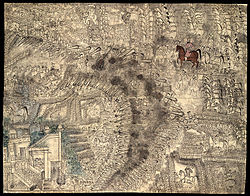| Nawab Saadullah Khan Bahadur Rohilla | |||||
|---|---|---|---|---|---|
| Nawab Of Rohilkhand Nawab of Moradabad Nawab of Jalesar Nawab of Faizabad Chief of the Rohilla | |||||
 Saadullah Khan accompanying Ahmed Shah Abidali in the Third Battle of Panipat | |||||
| Nawab of Rohilkhand | |||||
| Reign | 1754–1764 | ||||
| Predecessor | Abdullah Khan of Rohilkhand | ||||
| Successor | Faizullah Khan | ||||
| Regent | Hafiz Rehmat Khan | ||||
| Chief of the Rohilla | |||||
| Reign | 1754–1764 | ||||
| Predecessor | Abdullah Khan of Rohilkhand | ||||
| Successor | Faizullah Khan | ||||
| Nawab of Moradabad | |||||
| Reign | 1748–1754 | ||||
| Predecessor | Ali Mohammad Khan | ||||
| Nawab of Jalesar and Faizabad | |||||
| Reign | 1758–1764 | ||||
| Predecessor | Ahmed Shah Durrani | ||||
| Died | 1764 | ||||
| Burial | Ali Mohammed Khan Maqbara, Aonla | ||||
| |||||
| House | Rohilla (by Adoption) Barha | ||||
| Father | Ali Mohammad Khan | ||||
| Mother | Sarah Begum | ||||
| Religion | Islam | ||||
Nawab Abdullah Khan Bahadur Rohilla (died 1775) [1] was the third son of Nawab Ali Muhammad Khan of Rohilkhand and succeed his brother to the throne of Rohilkhand. [2] [3]